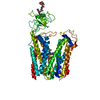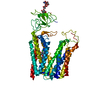+ Open data
Open data
- Basic information
Basic information
| Entry | Database: PDB / ID: 8hnb | ||||||
|---|---|---|---|---|---|---|---|
| Title | Cryo-EM structure of human OATP1B1 in apo state | ||||||
 Components Components | Solute carrier organic anion transporter family member 1B1 | ||||||
 Keywords Keywords | MEMBRANE PROTEIN / transporter / OATP1B1 / organic anion transporting peptide | ||||||
| Function / homology |  Function and homology information Function and homology informationDefective SLCO1B1 causes hyperbilirubinemia, Rotor type (HBLRR) / Organic anion transport by SLCO transporters / sodium-independent organic anion transport / : / thyroid hormone transmembrane transporter activity / prostaglandin transmembrane transporter activity / heme catabolic process / Atorvastatin ADME / organic anion transport / : ...Defective SLCO1B1 causes hyperbilirubinemia, Rotor type (HBLRR) / Organic anion transport by SLCO transporters / sodium-independent organic anion transport / : / thyroid hormone transmembrane transporter activity / prostaglandin transmembrane transporter activity / heme catabolic process / Atorvastatin ADME / organic anion transport / : / bile acid transmembrane transporter activity / Heme degradation / bile acid and bile salt transport / Recycling of bile acids and salts / monoatomic ion transport / xenobiotic metabolic process / basal plasma membrane / basolateral plasma membrane / membrane / plasma membrane Similarity search - Function | ||||||
| Biological species |  Homo sapiens (human) Homo sapiens (human) | ||||||
| Method | ELECTRON MICROSCOPY / single particle reconstruction / cryo EM / Resolution: 3.53 Å | ||||||
 Authors Authors | Shan, Z. / Yang, X. / Zhang, Y. | ||||||
| Funding support |  China, 1items China, 1items
| ||||||
 Citation Citation |  Journal: Cell Res / Year: 2023 Journal: Cell Res / Year: 2023Title: Cryo-EM structures of human organic anion transporting polypeptide OATP1B1. Authors: Ziyang Shan / Xuemei Yang / Huihui Liu / Yafei Yuan / Yuan Xiao / Jing Nan / Wei Zhang / Wenqi Song / Jufang Wang / Feiwen Wei / Yanqing Zhang /  Abstract: Members of the solute carrier organic anion transporting polypeptide (OATPs) family function as transporters for a large variety of amphipathic organic anions including endogenous metabolites and ...Members of the solute carrier organic anion transporting polypeptide (OATPs) family function as transporters for a large variety of amphipathic organic anions including endogenous metabolites and clinical drugs, such as bile salts, steroids, thyroid hormones, statins, antibiotics, antivirals, and anticancer drugs. OATP1B1 plays a vital role in transporting such substances into the liver for hepatic clearance. FDA and EMA recommend conducting in vitro testing of drug-drug interactions (DDIs) involving OATP1B1. However, the structure and working mechanism of OATPs still remains elusive. In this study, we determined cryo-EM structures of human OATP1B1 bound with representative endogenous metabolites (bilirubin and estrone-3-sulfate), a clinical drug (simeprevir), and a fluorescent indicator (2',7'-dichlorofluorescein), in both outward- and inward-open states. These structures reveal major and minor substrate binding pockets and conformational changes during transport. In combination with mutagenesis studies and molecular dynamics simulations, our work comprehensively elucidates the transport mechanism of OATP1B1 and provides the structural basis for DDI predictions involving OATP1B1, which will greatly promote our understanding of OATPs. | ||||||
| History |
|
- Structure visualization
Structure visualization
| Structure viewer | Molecule:  Molmil Molmil Jmol/JSmol Jmol/JSmol |
|---|
- Downloads & links
Downloads & links
- Download
Download
| PDBx/mmCIF format |  8hnb.cif.gz 8hnb.cif.gz | 110.3 KB | Display |  PDBx/mmCIF format PDBx/mmCIF format |
|---|---|---|---|---|
| PDB format |  pdb8hnb.ent.gz pdb8hnb.ent.gz | 78.5 KB | Display |  PDB format PDB format |
| PDBx/mmJSON format |  8hnb.json.gz 8hnb.json.gz | Tree view |  PDBx/mmJSON format PDBx/mmJSON format | |
| Others |  Other downloads Other downloads |
-Validation report
| Arichive directory |  https://data.pdbj.org/pub/pdb/validation_reports/hn/8hnb https://data.pdbj.org/pub/pdb/validation_reports/hn/8hnb ftp://data.pdbj.org/pub/pdb/validation_reports/hn/8hnb ftp://data.pdbj.org/pub/pdb/validation_reports/hn/8hnb | HTTPS FTP |
|---|
-Related structure data
| Related structure data |  34909MC  8hncC  8hndC  8hnhC  8k6lC M: map data used to model this data C: citing same article ( |
|---|---|
| Similar structure data | Similarity search - Function & homology  F&H Search F&H Search |
- Links
Links
- Assembly
Assembly
| Deposited unit | 
|
|---|---|
| 1 |
|
- Components
Components
| #1: Protein | Mass: 78790.750 Da / Num. of mol.: 1 Source method: isolated from a genetically manipulated source Source: (gene. exp.)  Homo sapiens (human) / Gene: SLCO1B1, LST1, OATP1B1, OATP2, OATPC, SLC21A6 / Production host: Homo sapiens (human) / Gene: SLCO1B1, LST1, OATP1B1, OATP2, OATPC, SLC21A6 / Production host:  Homo sapiens (human) / References: UniProt: Q9Y6L6 Homo sapiens (human) / References: UniProt: Q9Y6L6 |
|---|---|
| #2: Polysaccharide | 2-acetamido-2-deoxy-beta-D-glucopyranose-(1-4)-2-acetamido-2-deoxy-beta-D-glucopyranose Source method: isolated from a genetically manipulated source |
| #3: Sugar | ChemComp-NAG / |
| Has ligand of interest | Y |
| Has protein modification | Y |
-Experimental details
-Experiment
| Experiment | Method: ELECTRON MICROSCOPY |
|---|---|
| EM experiment | Aggregation state: PARTICLE / 3D reconstruction method: single particle reconstruction |
- Sample preparation
Sample preparation
| Component | Name: OATP1B1 / Type: COMPLEX / Entity ID: #1 / Source: RECOMBINANT |
|---|---|
| Molecular weight | Experimental value: NO |
| Source (natural) | Organism:  Homo sapiens (human) Homo sapiens (human) |
| Source (recombinant) | Organism:  Homo sapiens (human) / Cell: HEK293 Homo sapiens (human) / Cell: HEK293 |
| Buffer solution | pH: 8 |
| Specimen | Conc.: 9 mg/ml / Embedding applied: NO / Shadowing applied: NO / Staining applied: NO / Vitrification applied: YES |
| Vitrification | Instrument: FEI VITROBOT MARK IV / Cryogen name: ETHANE / Humidity: 100 % / Chamber temperature: 281 K |
- Electron microscopy imaging
Electron microscopy imaging
| Experimental equipment |  Model: Titan Krios / Image courtesy: FEI Company |
|---|---|
| Microscopy | Model: FEI TITAN KRIOS |
| Electron gun | Electron source:  FIELD EMISSION GUN / Accelerating voltage: 300 kV / Illumination mode: FLOOD BEAM FIELD EMISSION GUN / Accelerating voltage: 300 kV / Illumination mode: FLOOD BEAM |
| Electron lens | Mode: BRIGHT FIELD / Nominal magnification: 105000 X / Nominal defocus max: 2300 nm / Nominal defocus min: 1500 nm / Cs: 2.7 mm |
| Specimen holder | Cryogen: NITROGEN / Specimen holder model: FEI TITAN KRIOS AUTOGRID HOLDER |
| Image recording | Electron dose: 50 e/Å2 / Detector mode: SUPER-RESOLUTION / Film or detector model: GATAN K3 (6k x 4k) |
| EM imaging optics | Energyfilter name: GIF Quantum ER / Energyfilter slit width: 20 eV |
- Processing
Processing
| EM software |
| |||||||||
|---|---|---|---|---|---|---|---|---|---|---|
| CTF correction | Type: NONE | |||||||||
| 3D reconstruction | Resolution: 3.53 Å / Resolution method: FSC 0.143 CUT-OFF / Num. of particles: 325578 / Symmetry type: POINT |
 Movie
Movie Controller
Controller







 PDBj
PDBj








